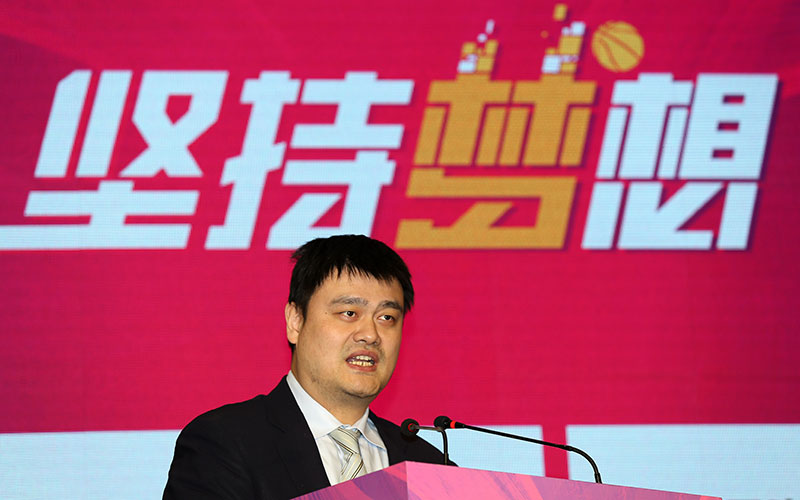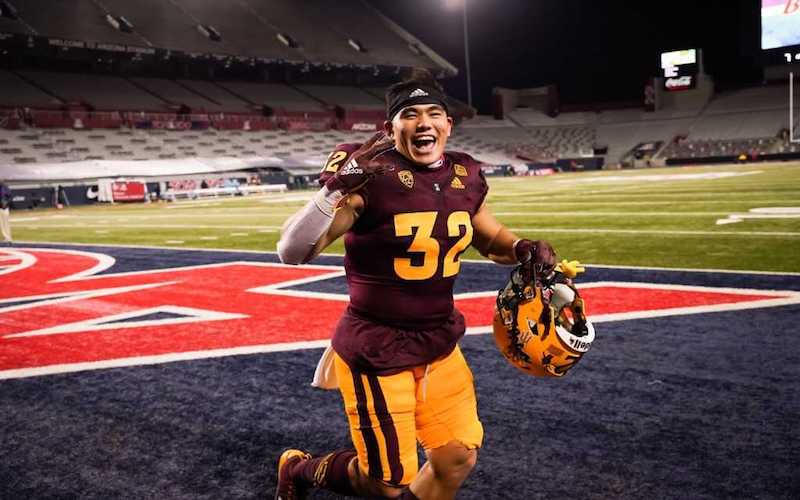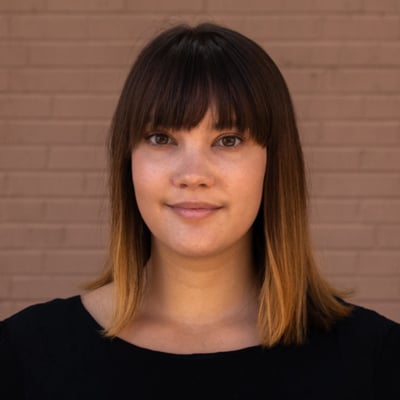
Mike Magpayo of the University of California, Riverside became the first head coach of full Asian descent to win a Division I college basketball game in the 82 years since the NCAA first crowned a college basketball champion. (Photo by Jayne Kamin-Oncea/Getty Images)

Former NBA player Yao Ming has made it a priority to promote his sport, including the Women’s Chinese Basketball Association. (Photo by VCG/VCG via Getty Images)
PHOENIX – Mike Magpayo found out he made history while watching ESPN’s “SportsCenter” on the couch with his wife, Caroline, and his newborn son, Luka.
On Dec. 1, Magpayo, 41, coached the University of California, Riverside men’s basketball team to a win over the Washington Huskies in Las Vegas. The Highlanders boisterously celebrated in the locker room and took a picture Magpayo describes as “Ocean’s 11 style” in front of the Bellagio Fountain, posing with arms crossed, hands in pockets and expressions so serious they come across as cool and collected even behind their masks.
That night, Magpayo drove home to Riverside, where Caroline and Luka were waiting. While they relaxed on the couch, Magpayo’s longtime friend and Bishop O’Dowd High School basketball coach, Lou Richie, texted him, “You’re on ‘SportsCenter.’”
It was only once he turned on the TV that Magpayo, whose parents are Filipino, realized he was the first head coach of full Asian descent to win a Division I college basketball game in the 82 years since the NCAA first crowned a college basketball champion.
“It was really the furthest thing from my mind,” Magpayo said. And maybe, he said, that was because he was raised to be humble.
“I think my parents must have said that word to me 1,000 times when I was growing up. I’d have a good basketball game and they’re like, ‘Mike, be humble.’”
It was an important story to be told. Lack of representation for Asian Americans in college athletics reinforces existing stereotypes, preventing more Asians from getting involved in college athletics, according to Christina Chin, an assistant professor of sociology at California State University Fullerton who studies Japanese youth basketball leagues.
“If you just don’t see yourself in the mainstream playing those sports and doing well and being interviewed and being a leader, it’s really hard for youth to envision themselves and aspire to those roles,” she said.
Asian Americans are the fastest growing demographic in the United States, according to the Pew Research Center in 2017, and they became the fastest growing racial or ethnic group among U.S. voters in 2020.
Meanwhile, Asians, Native Hawaiians and Pacific Islanders account for only 2% of student athletes in the NCAA, a figure that hasn’t changed since 2012. The most prominent example this year is Johnny Juzang, a shooting guard for UCLA’s basketball team, who put up impressive numbers in the NCAA Tournament, including 29 points in the Bruins’ loss in the Final Four.

Jackson He became the first Chinese-born player to score a touchdown in FBS history after Arizona State’s 70-7 win over Arizona on Dec. 11, 2020. His success can help counter Asian American stereotypes in athletics. (Courtesy of Sun Devil Athletics)
On Dec. 11, Arizona State running back Jackson He made college football history, becoming the first Chinese-born player to score a touchdown in FBS history. He told Cronkite News it was important to represent his Chinese heritage in that moment.
“I was like man, the only thing I can do is just point out the name on my back because it’s representing,” He said.
“It’s pretty cool to have my real Chinese name on it. It’s more than just my name.”
Meanwhile, reports of hate crimes against Asian Americans are on the rise, spotlighting other challenges the community is facing.
***
Many Asian athletes who play professional golf or baseball in the United States are recruited directly from abroad. That was the case for 7-foot-6 Yao Ming, a Chinese superstar who was the first prominent Asian NBA player.
Then came Jeremy Lin, who went undrafted despite earning many accolades at Harvard. Lin became the first American of Chinese or Taiwanese descent to play in the NBA when he signed with the New York Knicks in 2011. After being promoted to the starting lineup, he led the Knicks on a seven-game winning streak and to the playoffs for the first time in six seasons.
When it comes to important moments for Asian Americans in sports history, “Jeremy Lin would be really obvious, probably more so than any other figure,” said Oliver Wang, an associate professor of sociology at California State University Long Beach and author of “Everybody Loves an Underdog: Learning From Linsanity.”
People trying to explain how Lin flew under the NBA’s radar before his amazing run with the Knicks didn’t have the tools or experience to talk about race and ethnicity in sports, Wang said. As a result, they ended up falling back on untrue narratives built upon existing beliefs and stereotypes about Asian Americans.
“It just becomes a self-reinforcing loop,” Wang said.
Wang, whose research centers on Asian Americans in American pop culture, said he sees two dominant narratives for Asian Americans in athletics. The first is that they are exceptions to the rule. Because we don’t expect to see Asian American point guards, every story about an Asian point guard treats them as a “curio” who came out of nowhere, which is what happened to Lin, who now plays for Warriors in the G League.
The second narrative relates to the model minority myth, or the false idea that, through hard work and perseverance, Asian Americans show how anyone who is a member of an ethnic or racial minority can overcome the oppressive social structures that work to keep them down. That means Asian athletes in such sports as golf, figure skating or martial arts always are treated as if their work ethic is the only factor that explains their success.
Though Ming broke that mold, he wasn’t someone whom Asian Americans could closely relate to. For starters, he was born abroad. Chin offers an additional reason:
“Let’s be honest: Nobody looks like Yao Ming,” Chin said. “He’s just this giant man.”
When Lin entered the NBA stage, his less imposing frame – he’s 6-3 – and American upbringing made him more relatable. But it didn’t save him from being treated as an oddity.
Wang said that, in basketball specifically, Asian athletes aren’t seen the same way that Black or white athletes are. Black and white athletes’ mere existence doesn’t qualify them as phenomena or minimize them as merely products of their upbringing.
“We don’t talk about how white culture has produced these superstar athletes,” Wang said.
It is often these reductive portrayals and stereotypes that work to keep young Asians out of competitive athletics, researchers said. One such stereotype is the idea that Asian Americans are physically weak and passive, something that goes counter to the idea of strength and aggressiveness as key aspects to athletic success.
In a study, Chin noted the Japanese American participants she recruited often were chosen last in pickup games at parks in Southern California then went unguarded because of the assumption that they couldn’t possibly be a threat.
“They had to really prove themselves a lot more to their high school coaches or to other players,” Chin added. Her participants often were able to push back against those stereotypes – no one is foolish enough to leave a player open after they sink several shots – but not everyone has to prove their worth to be included in the game.
Then there’s the widespread belief that Asian Americans’ main focus is on academic excellence. That, Chin says, not only turns young Asian Americans away from competitive sports, it also influences who’s more likely to be recruited.
“It all comes down to not just the players themselves,” Chin said, “but who are the folks who are making those decisions at the back end?”
That’s where increasing diversity in coaching comes into play.
Magpayo’s rise to head coach at UC Riverside was more like a meandering hike with many switchbacks than an elevator straight to the top.
After graduating from University of California, Santa Barbara with a business degree, Magpayo worked at Comerica Bank before starting a successful real estate company in 2003 with his best friend from college, Gil Manzuri.
No matter what else he did, though, Magpayo always coached high school basketball. From November to March, he devoted himself to leading a team of students to success on the court while also leading a team of employees as their CEO.
“I was basically coaching a company,” Magpayo said.
His real estate company made it through the housing market crash, but barely: It went from 40 employees in 2006 to 10 in 2009, he said. Magpayo didn’t want that to happen again so he went to New York University to get a master’s degree in real estate in 2010.
Before he moved, he emailed pretty much every college basketball coach in New York asking whether he could contribute to their programs, at no cost to them. He had done the same in Southern California but received only negative responses.
In New York, he received just one response – but it was the one response he needed.
Kyle Smith, who’s now the coach at Washington State, at the time was coaching the men’s team at Columbia University, and he told Magpayo to meet him on campus for a test.
As it turned out, Magpayo couldn’t work for Smith for free because they were at different universities. Uncompensated work, in that case, would be a breach of NCAA rules. Magpayo ended up helping out with Columbia’s children’s summer basketball camps. He did so well that Smith offered him a paid job as director of operations.
Magpayo said he thinks his business background contributed to getting the opportunity. Smith is an analytics-focused coach. Magpayo’s knowledge on how to build out files and spreadsheets, and his experience with paperwork such as expense reports, contributed to his value on the coaching staff.
Since Smith was the only one to give him a shot, Magpayo was doubtful that he would ever have a chance to get into Division I coaching again. He knew he had to take the job because the happiest time of his year was always November to March when he was coaching basketball.
College basketball staffs have a head coach, three assistant coaches and a director of operations. According to NCAA rules, only the head coach and assistant coaches can coach on the court. Often, directors of operations strive for promotions so they can coach on the sidelines, too.
Smith promoted Magpayo after nine months, but Magpayo said he’s seen a lot of Asian coaches get stuck in the operations role. If he were to guess, Magpayo pointed to stereotypes that Asian people are more academically minded and, because of that, people assume an operations job might suit them best.
Sometimes getting that promotion requires more aggressiveness than many Asian Americans are raised to exert, Magpayo said.
“Coach Smith used to tell me, like, ‘Are you always going to be so humble? Are you always going to be so self-deprecating?’” he recalled.
Magpayo struggled because of the humility his parents instilled in him. He said it’s not part of Asian culture to step on people’s toes because respect is so important. As the founder and president of the Asian Coaches Association, Magpayo tells other Asian Americans in basketball what Smith told him: You have to tell people how good you are so they will know why they should hire you – and it’s not disrespectful to do that.
The idea of starting the Asian Coaches Association came from a conversation with Smith and the rest of the Columbia staff one summer. Smith suggested starting the Filipino Coaches Association, mentioning how the Jewish coaches had a breakfast at the Final Four convention of the NCAA Tournament and the African American and Latino coaches also had meetings.
“I was like, there’s going to be two of us,” Magpayo said. “It’s going to be me and Erik Spoelstra,” who has coached the Miami Heat since 2008.
Despite his quip, Magpayo liked the idea and the Asian Coaches Association was born. Its first meeting at the 2012 NCAA Final Four drew 13 people, with about five Asian coaches and the Columbia staff who came to support Magpayo.
At the last meeting in 2019, there were more than 130 people, including Spoelstra. The association also started a similar event at the women’s Final Four, which had about 60 attendees.
To achieve those heightened numbers, Magpayo put his business background to use. He got sponsors to pay for an open bar at their third meeting so it would appeal to more than just Asian Americans. He realized just having the Asian coaches network together wouldn’t help them advance: They needed to connect with others in the industry.
From there, it took off. It’s now so large that it’s not obvious who the target demographic of the event is.
“People always joke around, ‘Where’s the Asian coaches at the Asian Coaches Association?’” Magpayo said.
Magpayo estimates there are 15 Asian coaches, including those of mixed descent, in Division I basketball, out of approximately 1,755 coaching jobs at the 351 schools in Division I. He also estimates there are 40 to 50 Asian coaches in Division II and III. Magpayo tries to get to know as many of them as possible.
Pat Chun, who is the only Asian athletic director in a Power Five conference, works at Washington State with Smith, so he knows Magpayo’s “family tree.” He has spoken at the association’s meetings and gave Magpayo credit for developing much needed community and camaraderie through the association.
“I’ve made it a point throughout my career in our industry to support and advise and offer counsel whenever needed,” Chun said.
Growing up in the 1980s, Chun said, he never felt like he had anyone working in sports to look to, which is why he takes his responsibility to represent Asian Americans so seriously. Like Magpayo and scholars like Chin, Chun believes the lack of Asians in sports might keep young Asian people from believing they deserve to be in basketball.
“Some of those stereotypes really emerge from under-representation,” Chin said.
She wishes there were more Jeremy Lins because it’s hard to envision breaking through stereotypes without someone to show what that might look like. Chun agreed.
“For younger people, it’s just great to see someone break through that has the same background, that may look like you to a certain degree,” Chun said. “That just gives you a little bit of hope.”
Chun said hope from seeing someone like Magpayo is merely the first step toward creating lasting change when it comes to Asian American representation in college sports.
“The challenge here is there’s decades upon decades of hiring practices job in our industry that is predominantly Caucasian at the presidential level so that brings inherent challenges, but the world keeps changing,” Chun said, as younger generations become more “in tune with the impact of racism, stereotyping and xenophobia.”
Magpayo hopes the Asian Coaches Association can help promote conversations about stereotypes in sports and reassure Asian Americans they belong in an industry where they aren’t represented.
He said Spoelstra’s success in the NBA helped him believe he could achieve the dream of coaching at the Division I level. He doesn’t want to take for granted what it means for him to achieve that dream.
Magpayo spoke on Zoom from his son’s nursery. He was seated on a rocking chair draped with a navy blue blanket, covered in smiling cartoon whales. The wall behind him displayed a collage of pictures of Luka, who’s named for Luka Dončić, an up-and-coming NBA star. In the background, Luka babbled and Caroline comforted him.
“I really do think I’m the luckiest man in the world right now,” Magpayo said.
He might be, but, as Chun, who knows well the difficulties of making history, said, “The responsibility is more about making sure I’m not the last. It’s one thing to be the first. It’s another thing to be the only.”


